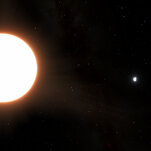Astronomers have come across the shiniest planet ever found, a mere 265 light years from our solar system. But that’s hardly its only standout trait. Shrouded by thick metallic clouds, this world’s temperature reaches a blistering 3,000 degrees Fahrenheit, and it quite likely rains scorching-hot drops of titanium.
The find, named LTT 9779 b, was described in a published this month in the journal Astronomy & Astrophysics. Nearly five times as big as Earth, it’s one of the few ultrahot, gaseous exoplanets of this size that scientists have discovered. “This opens a new window into understanding these kinds of extreme, Neptune-like planets — maybe some of the rarest planets that exist,” said James Jenkins, an astronomer at Diego Portales University in Chile, describing this one as probably having “a nasty, harsh, dark environment.
” in 2018 by NASA’s , scientists quickly realized that this planet was an oddball. Usually worlds with short orbital periods are either like hot Jupiters, more than 10 times the size of Earth, or are small rocky orbs whose atmospheres have been stripped away by stellar radiation. But LTT 9779 b, which sprints around its star once every 19 hours, is midsize — making it one of four or five planets in the so-called Neptune desert, and the only one with an intact atmosphere.
Optical observations made with the European Space Agency’s uncovered even more about this mysterious world. Dr. Jenkins and his colleagues studied slight changes in the light arriving to the instrument as the planet slipped behind, then in front of, its host star.
Combined with infrared data collected by NASA’s , the team derived information about the planet’s thermal and chemical properties. Their results reveal that the planet reflects a whopping 80 percent of the light from its sun. (That beats Venus, the shiniest neighbor in our own solar system.
) The researchers also worked out that its clouds are rich in silicates — the minerals that make up glass — and titanium. That these clouds are metallic might be what protects the otherwise endangered atmosphere: Most of the stellar radiation bounces off this material and back into space, rather than penetrating the clouds and blowing them away. It’s still a mystery how a planet so hot can even form clouds, but Dr.
Jenkins speculates that it might be akin to the way steam condenses in the air during a hot shower. It’s fascinating that a planet like this can exist at all, said Knicole Colón, an astrophysicist at NASA Goddard Space Flight Center who was not involved in the work. “This initial result is fantastic, because it’s telling us that there’s more to the story,” she added.
Plans to follow up with the Hubble and James Webb Space Telescopes are in motion. Those telescopes will provide better optical data that will be captured at higher energies and throughout the planet’s full orbit. Additional observations in the infrared are also lined up for .
According to Dr. Colón, these measurements will sharpen knowledge about how the planet’s brightness varies along its orbit and possibly even at different altitudes. Over the next five years, Dr.
Jenkins and his colleagues will also be hunting for more planets in the same star system, which might uncover clues about how this exotic world formed. But LTT 9779 b may just be the benchmark for such ultrahot Neptunes. The more the team learns, the more they realize how rare it really is.
“It’s a super important world,” Dr. Jenkins said, adding that the diversity of planets in the cosmos stretches far beyond those found in our own solar system. “Hopefully, we’ll stumble across another.
”.
From: nytimes
URL: https://www.nytimes.com/2023/07/27/science/space/titanium-clouds-exoplanet.html



